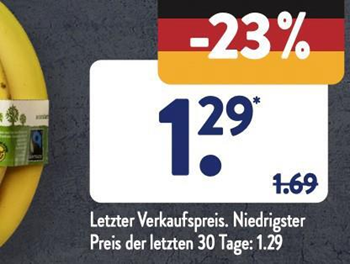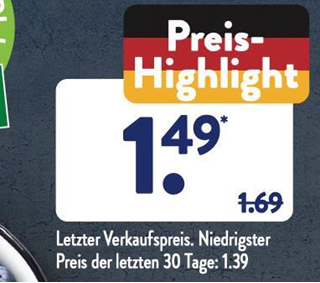Impact of the CJEU Ruling on Discount Advertising in Europe: What It Means for Businesses
On 26 September 2024, the Court of Justice of the European Union (CJEU) issued a landmark ruling (Case C-330/23) that significantly restricts how companies can lawfully advertise strikethrough pricing. According to the CJEU, price reductions must be calculated and communicated based on the lowest price within the last 30 days. The previous practice of using the most recently charged price as a reference for strikethrough pricing is no longer permissible.
What was the case about?
The case involved the following advertisement in an Aldi brochure:


As shown in the image, the strikethrough price was not based on the lowest price of the past 30 days (€1.29) but rather on the most recently charged selling price (€1.69). The Verbraucherzentrale Baden-Württemberg (Consumer Protection Association of Baden-Württemberg) argued that this was misleading for consumers. In the association's view, the discount should be based on the lowest price charged during the last 30 days. Aldi Süd, on the other hand, contended that the discount could be calculated using the most recently charged price and that it would be sufficient to indicate the lowest price of the last 30 days purely for informational purposes.
The Düsseldorf Regional Court was thus asked to determine whether it was sufficient to include the lowest price of the last 30 days in the fine print, while the main advertisement for the price reduction—whether through percentage discounts or phrases like "price highlight"—used another, typically the most recent, higher price as the strikethrough price.
Both European and German regulations do not provide specific guidelines on how the "prior price" must be indicated in the case of price reductions. Section 11 of the German Price Indication Regulation (PAngV), which implements Article 6a of the Price Indication Directive (Directive 98/6/EC), does not prescribe the method of presentation, as the Düsseldorf Regional Court also observed. Similarly, the recitals of the Directive offer no additional insights. Article 4(1) of the Directive merely requires that the selling price be unambiguous, easily identifiable, and clearly legible, without detailing how the reference price should be presented.
The Düsseldorf Regional Court referred these questions to the CJEU for a preliminary ruling.
The decision
The CJEU ruled that Article 6a(1) and (2) of Directive 98/6/EC requires that a price reduction for a product, which is advertised by a trader in the form of a percentage or through a promotional statement highlighting the attractiveness of the reduced price, must be determined based on the "prior price."
The "prior price" is defined as the lowest price applied by the trader during a period of at least 30 days before the price reduction was applied. It is not the most recently charged price.
Thus, it is insufficient to simply mention the "prior price" without using it as the actual basis for calculating the discount. Such a practice would conflict with the Directive’s objective of improving consumer information, which requires clear and unambiguous details about prices and how discounts are calculated.
The Court emphasized that traders must be prevented from misleading consumers by raising prices shortly before a price reduction is announced, thereby creating false price reductions. An interpretation that allows the "prior price" to be mentioned solely as information, without using it as the basis for the discount, would undermine this objective.
Implications for businesses: What the CJEU ruling means for strikethrough pricing
The CJEU’s ruling imposes much stricter limits on companies that use strikethrough pricing in their discount advertising. This will lead to significant changes, particularly for promotions in flyers, brochures, or online sales. Previously, it was common practice to cross out a higher, most recently charged price and promote a discount. This practice is no longer allowed under the new rules.
A concrete example highlights the issue: Suppose a pair of trousers originally costs €100, is then offered in a sale for €80, and later returns to its original price of €100. If the retailer then wanted to offer a 10% discount, they might have previously used the most recent price (€100) as the strikethrough price, advertising the new discounted price of €90. Under the new ruling, this is no longer allowed unless that price was the lowest within the last 30 days. In such cases, strikethrough pricing is effectively no longer viable.
For businesses, this ruling represents a significant restriction on existing discount strategies, especially in industries with frequent price changes, such as fashion. Companies must now be vigilant about how they advertise discounts, ensuring that the advertised discount is always based on the lowest price in the last 30 days.







.jpg?t=a-s&arw=16&arh=9&arm=focuspoint&w=500)

